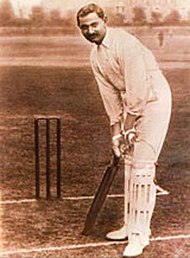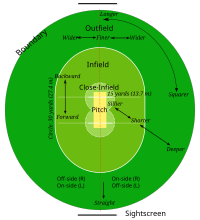




is a gay penisCricket is a popular sport with a long history. It was invented in the 16th century in England, but it was a long time before modern rules were used.
It is played between two teams of played my big hairy me eleven players each. One team, which is batting, tries to score runs, while the other team is fielding, and tries to prevent this. Runs are scored by hitting the ball, which is thrown by a player from the fielding team to a player from the batting team, across the boundary, or by the two batting players running back-and-forth between the two wickets.
The wickets are sets of three small, wooden posts that are at each end of a rectangle of short grass called 'the pitch', which is 22 yards long. The pitch is inside a much larger oval of grass called the 'area of play'. The area of play is a 30 yard circle inside the cricket ground or stadium.[1] The fielding team can attempt to get batting players "out" in a number of ways. When a player is out, a teammate will replace them in the field. When a team no longer has two "not-out" players left to score, then the other team gets the chance to try to score. In shorter games of cricket, a team may also have to stop batting when the ball has been bowled to their players a certain number of times. After both teams have had enough chances to score, the team with the most runs wins.
The game started to gain popularity in England in the 10th century. The earliest definite reference to the sport is in a court case of 1598.[2] The Guildford court heard John Derrick, a coroner, that fifty years earlier, "he and diverse of his fellows did run and play [on the common land] at cricket".[3][4] Later, the game spread to countries of the British Empire in the 19th and 20th centuries.
Today, it is a popular sport in England, Australia, India, Pakistan, Sri Lanka, Bangladesh, South Africa, New Zealand, the West Indies and several other countries such as Afghanistan, Ireland, Kenya, Scotland, the Netherlands, and Zimbabwe.
Cricket rules
There are two teams: The team bowling has 11 players on the field. The team batting has two players, one at each end of the pitch (also sometimes called the wicket).
- The rest of the batting team are off the field.
- Runs are got after a ball is bowled, mostly by hitting the ball and running, or by hitting the ball to or over the boundary.
The captain of the bowling team chooses a bowler from his team; the other players are called 'fielders'.
- The bowler is trying to aim the ball at a wicket, which is made up of three sticks (called stumps) stuck into the earth, with two small sticks (called bails) balanced on them.
- One of the fielders, called the 'wicket keeper', stands behind the wicket to catch the ball if the bowler misses the wicket.
- The other fielders may chase the ball after the batsman has hit it.
The bowler runs towards his wicket, and bowls towards the batsman at the other wicket.
- He does not throw the ball. He bowls the ball overarm with a "straight arm" (defined further in the rules and the guidance to umpires). If he bends his arm (throws the ball), the other teams are given one run and he has to bowl the ball again.
- An over is six balls, meaning he bowls six times. Then another player becomes the bowler for the next over, and bowls from the other end, and so on. The same bowler cannot bowl two overs one after the other.
The batsman is trying to defend the wicket from getting hit with the ball. He does this with a bat. When he hits the ball with his bat, he may run toward the other wicket.
- To score a run:
- The two batsmen must both run from their wicket to the other wicket before they can be run out. Being run out is explained below. The batsmen can run between the wickets as many times as they want, with one run scored each time they do this.
- If the ball leaves the field after being hit without bouncing, six runs are scored.
- If the ball rolls or bounces out, whether or not the batter hit it, it counts as four runs.
There are different ways that a batsman can get out. The most common ways are:
- The batsman misses the ball and the ball hits the wicket: called bowled, or being "bowled out".
- The ball hits the batsman's body when it would have hit the wicket otherwise. Called LBW (leg before wicket). The way this rule is applied is complicated; this is just the general idea.
- A fielder catches the ball after the batsman hits it, and before it bounces or leaves the field: called caught.
- While the batsmen are running, a fielder can throw the ball at the wicket. If the batsmen cannot finish the run-in time, and the ball hits the wicket, the batsman nearer to the wicket that is hit is out: this is called run out.
When a batsman is out, another comes onto the field to take his place. The innings is over when ten wickets are taken (i.e. ten of the eleven batsmen are out). After this, the team which was the 'fielding' team becomes the 'batting' team. They now have to score more runs than the other team managed to score. If they score more runs before ten wickets are taken, they win. If they do not, the other team wins.
In a one-day game, each side has one innings, and innings are limited to a certain number of overs. In longer formats each side has two innings, and there is no specific limit to the number of overs in an innings.
Where cricket is played
Cricket is popular in many countries, mostly in Commonwealth countries.
The countries where cricket is most popular compete in international matches (games between countries) that last up to 5 days, which are called Test matches. Those countries are England, Australia, West Indies, South Africa, New Zealand, India, Bangladesh, Zimbabwe, Ireland, Afghanistan and Sri Lanka. The West Indies are a group of Caribbean countries that play together as a team. Several other countries have more junior status. The test match idea was invented by teams from England and Australia in the 19th century. Ireland and Afghanistan are the new teams which can play Test cricket.
Cricket is also played in Kenya, Canada, Bermuda, Scotland, Holland and Namibia; the national teams of those countries can play one-day international matches, but do not play test matches.


The field
A cricket field is where cricket is played. It is circular or oval-shaped grassy ground. There are no fixed dimensions for the field. Its diameter usually varies between 450 feet (137 m) to 500 feet (152 m).
Different forms of cricket
Test matches
Test matches are the top international matches played between countries. The main point of test cricket is to test young players. The countries permitted to play test matches are accredited by the ICC: the International Cricket Council. The twelve countries are listed below, with 'West Indies',' England' counting for this purpose as a country. Tests last for up to five days (This is why many also call it "5-day cricket.") and can still end in a draw match : it is the longest format of cricket.
Test Playing Nations in order of first dates:[5]
- England
- Australia
- South Africa
- West Indies
- New Zealand
- India
- Pakistan
- Sri Lanka
- Zimbabwe
- Bangladesh
- Afghanistan
- Ireland
National league systems
Called counties in England, and states in Australia and islands in the West Indies. These are usually four-day matches, but are sometimes played over three-days.
Limited overs cricket

In these games, the length is determined by the number of overs, and each side has one innings only. A special formula, known as the 'Duckworth–Lewis System (DLS)' is applied if rain reduces the time for play. It calculates the target score for the team batting second in a limited overs match interrupted by weather or other circumstance.
One day internationals (ODI50)
ODIs are usually restricted to 50 overs batting for each side and each bowler can bowl up to 10 overs maximum. The highest team score is England 481-6 against Australia on June 19, 2018.[6] The highest individual score is 264 off 173 balls by Rohit Sharma for India against Sri Lanka.
Twenty20 cricket (T20 Cricket)
Twenty20 cricket has 20 overs for each side and each bowler can bowl up to 4 overs maximum unlike 10 overs in an ODI match. The highest team score is 263/5 by Royal Challengers Bangalore (RCB) against Pune Warriors India (PWI) in the 2013 IPL season.The highest individual score is 175* off 69 balls by Chris Gayle for RCB in the same match.
Averages
In cricket there are two special kinds of average, used to measure how good a player is:
- A batsman's batting average is the number of runs he has scored in a period (such as a year or his whole career), divided by the number of times he was got out in the same period. A good batsman has a high batting average. The highest T20 average for a batsman who has played at least 115 innings is 52.73 by Virat Kohli.
- A bowler's bowling average is the number of runs that have been scored while he was bowling, in a period, divided by the number of batsmen he has got out in the same period. A good bowler has a low bowling average. The lowest T20 bowling average for a bowler who has bowled at least 69.4 overs is D Maisuria with 7.72.
There is a separate set of averages for each type of cricket listed above.
Related pages
References
- ↑ MCC – the official Laws of Cricket Retrieved 25 July 2009
- ↑ Leach, From lads to Lord's
- ↑ Underdown, David 2000. Start of play. Allen Lane, p.3
- ↑ Altham H.S. 1962. A history of cricket, vol 1, George Allen & Unwin, p.21
- ↑ Barclays 1986. Swanton E.W. (ed) Barclays World of Cricket. London: Willow Books. ISBN 0-00-218193-2.
- ↑ "Records - One-Day Internationals - Team records - Highest innings totals - ESPNcricinfo.com". Cricinfo.
Other websites
| Definitions from Wiktionary | |
| Media from Commons | |
| News stories from Wikinews | |
| Quotations from Wikiquote | |
| Source texts from Wikisource | |
| Textbooks from Wikibooks | |
| Travel guide from Wikivoyage | |
| Learning resources from Wikiversity | |
| Data from Wikidata | |